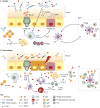The Microbiome, Timing, and Barrier Function in the Context of Allergic Disease
- PMID: 27096316
- PMCID: PMC4869964
- DOI: 10.1016/j.immuni.2016.02.002
The Microbiome, Timing, and Barrier Function in the Context of Allergic Disease
Abstract
Allergic disease affects millions. Despite many advances in our understanding of the immune system in the past century, the physiologic underpinning for the existence of allergy remains largely mysterious. Food allergies, in particular, have increased dramatically in recent years, adding a new sense of urgency to unraveling this mystery. The concurrence of significant lifestyle changes in Western societies with increasing disease prevalence implies a causal link. Demographic variables that influence the composition and function of the commensal microbiota early in life seem to be most important. Identifying the evolutionary and physiologic foundations of allergic disease and defining what about our modern environment is responsible for its increased incidence will provide insights critical to the development of new approaches to prevention and treatment.
Copyright © 2016 Elsevier Inc. All rights reserved.
Figures

References
-
- Abrahamsson TR, Jakobsson HE, Andersson AF, Bjorksten B, Engstrand L, Jenmalm MC. Low diversity of the gut microbiota in infants with atopic eczema. The Journal of allergy and clinical immunology. 2012;129:434–440. - PubMed
-
- Alduraywish SA, Lodge CJ, Campbell B, Allen KJ, Erbas B, Lowe AJ, Dharmage SC. The march from early life food sensitization to allergic disease: a systematic review and meta-analyses of birth cohort studies. Allergy 2015 - PubMed
-
- Arrieta MC, Stiemsma LT, Dimitriu PA, Thorson L, Russell S, Yurist-Doutsch S, Kuzeljevic B, Gold MJ, Britton HM, Lefebvre DL, et al. Early infancy microbial and metabolic alterations affect risk of childhood asthma. Science translational medicine. 2015;7:307ra152. - PubMed
-
- Asher MI, Montefort S, Bjorksten B, Lai CK, Strachan DP, Weiland SK, Williams H. Worldwide time trends in the prevalence of symptoms of asthma, allergic rhinoconjunctivitis, and eczema in childhood: ISAAC Phases One and Three repeat multicountry cross-sectional surveys. Lancet. 2006;368:733–743. - PubMed
Publication types
MeSH terms
Substances
Grants and funding
LinkOut - more resources
Full Text Sources
Other Literature Sources
Medical
Miscellaneous

